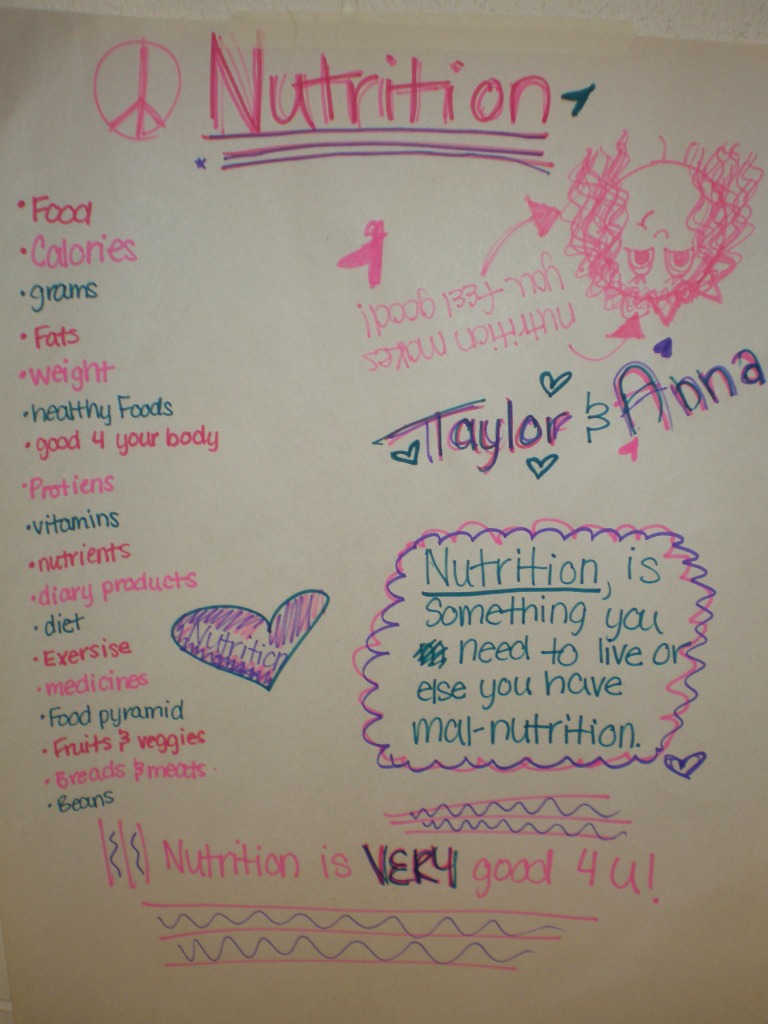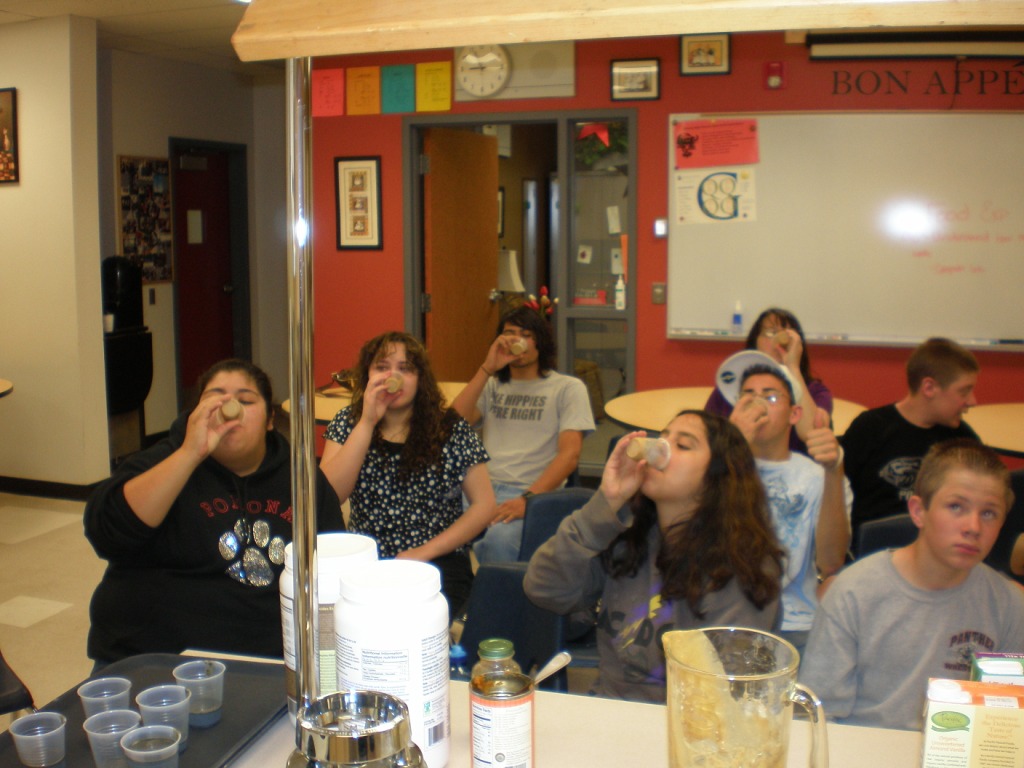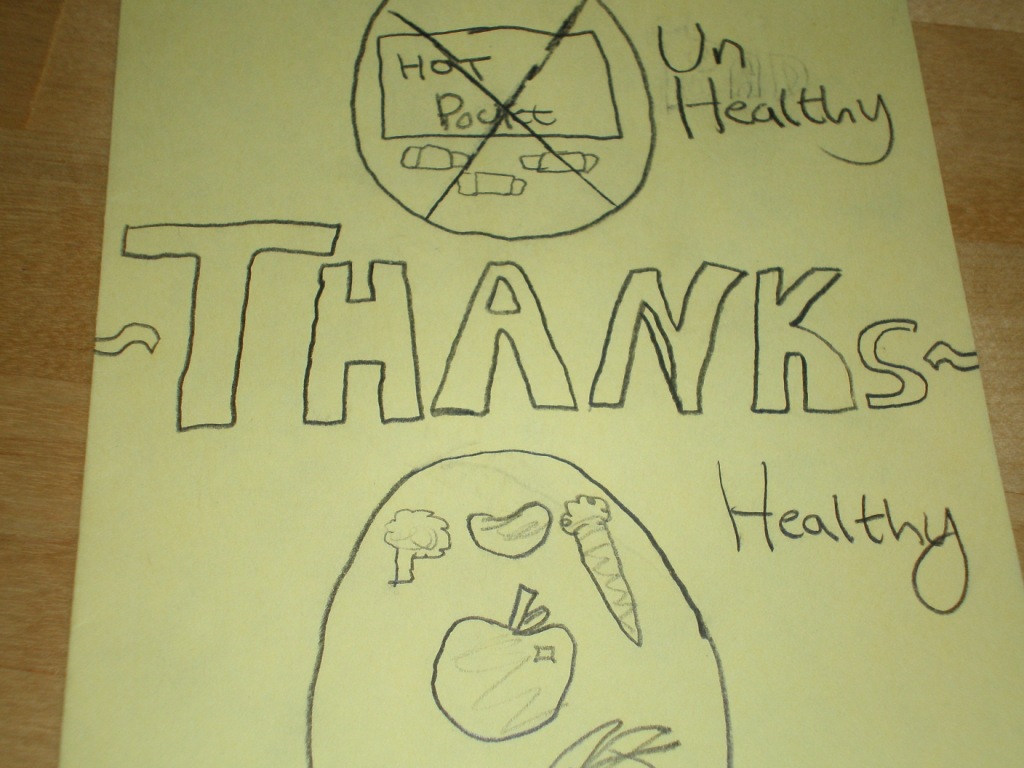Kids these days, with their rock music and Frosted Flakes! Mr. Andrews learns ’em good.
130 junior high-schoolers + 70 high-schoolers + 2 weeks of food demos & lectures = My life in May 2009
Yes, I went back to school in May 2009.
But I wasn’t there to pick up teachers, score some creatine in the weight room, or brush up on chemistry. I was there to educate youngsters about the wonderful world of “eating like you give a damn.” (Unfortunately they wouldn’t let me call my course that. I think educators need a better PR department.)

My survey
I decided to take advantage of having access to 200 guinea pigs — I mean youth — over two weeks. I took a survey before each class and asked one simple question:
What did you eat for breakfast this morning and why?
The results? Wretched.
Breakfast
First off, the breakfast choices. I’ll list the responses they provided from most common to least common:
- Honey Bunches Of Oats (with cow’s milk)
- Honey Nut Cheerios (with cow’s milk)
- Bagel with cream cheese
- Pop-Tarts
- Frozen pancakes
- Frozen waffles
- Granola bar
- Frosted Flakes (with cow’s milk)
- Honey Comb (with cow’s milk)
- Frozen sausage
- Toast with butter (not sprouted grain)
- Orange Juice
- Lemonade
- Nothing
- Life cereal (with cow’s milk)
- Cocoa puffs (with cow’s milk)
- Toast with peanut butter
- Meatball sub
- Donuts
- Hot pockets
- Toaster Strudel
- Instant oats with fruit
- Sleeve of Oreos
- Sucker
- Tilapia
- Toast with hummus (this made my week)
Yikes! Most of these kids think they are “being healthy” due to breakfast consumption.
But are they really?
Would they be better off skipping breakfast? Most of the aforementioned foods are health degrading, not health promoting. I wouldn’t recommend any kid (or adult) I care about eat most of those foods regularly. The obvious exceptions include toast with peanut butter, tilapia, toast with hummus and oats/fruit. That’s about it.
After reading that breakfast food list, I’m sure you’re wondering why in the heck kids decided to eat that stuff for breakfast. Well, you won’t be finding any Nobel-prize worthy responses.
The most frequent answers:
“It was there.”
“I was in a hurry.”
“It tasted good.”
Earth to parents. Buy nutritious foods. The foods that are actually in the pantry and fridge? Well, people eat them. If they’re there, kids will eat them. If they’re not, they won’t.
Eating junk food today means disease and fatness tomorrow. Be smart. (Check out Parents – Be Smart, accessible to PN members.)
After-school snacks
I also chatted with several students about their after school snacks. Double yikes:
- Hot pockets
- Taco Bell (and a few other fast food places)
- Pizza rolls
- Candy
- Chips
- Cereal
- Pop-tarts
- Granola bars
Processed, processed, processed.
Do you feel like driving your car into the side of the Kraft factory right now too? I sure did.
But there were three kids that made me reconsider. One had a veggie omelet (it’s the same kid who had tilapia for breakfast – aka nutrition stud). One had an apple with peanut butter. And one had a peanut butter sandwich (but my hunch is that we’re talking Peter Pan on Wonder bread). So, there were a few promising snacks that encouraged me enough to forget about the Kraft factory take down.
It’s all about additions
After talking with the kids, I noticed that just like many adults, they focus on what they shouldn’t eat rather than what they should eat.
- “Mr. Andrews, are Pop-tarts healthy?”
- “Mr. Andrews, will candy really cause health problems?”
- “Mr. Andrews, what if I eat Honey Comb every day?”
- “Mr. Andrews, why should I avoid cow’s milk?”
- “Mr. Andrews, but I like my Pizza Rolls!”
- “Mr. Andrews, you’re a nutrition stud.” (Well, no one actually said this – but I know they were thinking it.)
Remember, nutritious eating is all about additions.
None of these kids are eating:
- 10 servings of veggies and fruits each day
- 1 cup of whole grains/day
- 1 cup of legumes/day
- ½ cup nuts & seeds/day
Those are the foods that provide nutrients. Those are the foods that are sustainable. If they focus on eating them, there won’t be much room left for the Honey Bunches of Oats bender.
The lecture & demo

My lecture was based on 9 Nutrition Realities. This presentation has come full circle and morphed into a kick butt presentation. There were lots of great questions and comments.
My food demos were based on Super Shake preparation. I figured super shakes would be a quick, nutritious and delicious breakfast/after school snack option.
The first shake I made was:
- Ice
- Frozen blueberries
- Kale
- Chocolate Vega
- Cacao Nibs
- Almond Milk
Second shake was:
- Ice
- Frozen banana
- Vanilla vegan proteins+
- Canned pumpkin
- Flax meal
- Almond milk
- Coconut flakes
- Cinnamon
Side note: Less than 5% of the students knew that kale, hemp seed, and non-dairy milks existed on planet Earth. Less than 10% knew what flax seed was.
Some kids enjoyed the shakes and some didn’t. The ones who didn’t seemed to fear the idea of putting veggies in a shake. This didn’t surprise me after learning about what type of foods the kids found appealing. How can kale, blueberries and hemp seeds win against Frosted Flakes, Pop-Tarts and Hot Pockets?
The ambitious students even came up with some super shake names:
For the kale, berry, chocolate shake:
- Green Monster
- Chocolate Leaf
- It’s Alive
For the pumpkin/vanilla shake:
- Pumpkin Pie Power

What the…?
Kids are calibrating their taste buds at an early age for overly stimulating foods. When they eat, they expect that surge of dopamine to follow shortly thereafter. What’s even scarier is how food preferences are being shaped and desensitized by the food industry.
The simple pleasures of natural foods, the ones that actually come unaltered from the soil, are becoming less common.
Why is this happening?
My guess is parents and society.
Parents (in general) aren’t passing down healthy eating traditions. Moreover, our society is a toxic food environment. It’s a psychology experiment for junk food consumption. And it appears to be working really well.
Most teens feel invincible and have few (if any) immediate repercussions of a disastrous lifestyle. However, in 20 years they’ll be calling PN in a panic wanting to know how to reverse heart disease and drop 50 pounds of fat.
Let’s reverse this trend. Let’s get people making smart choices from early on.
My challenge to you is this: Get involved with schools in your community and promote nutritious eating.
If we don’t do it, nobody will.
Learn more
Want to get in the best shape of your life, and stay that way for good? Check out the following 5-day body transformation courses.
The best part? They're totally free.
To check out the free courses, just click one of the links below.




Share